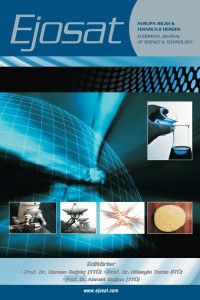Öz
Introduction: Lead protective apparels such as lead aprons, thyroid shields, and gonadal shielding are being used frequently for personal protection from radiation. These lead protectives may also be damaged frequently because of the usage and storage conditions. Therefore, the quality control of lead protective apparels which are performed once a year and the determination of damaged and risky ones are of great importance in the personal protection of radiation workers. In this study, it was aimed to determine the reject criteria by identifying damaged lead protective apparels.
Material and Method: In this study, the numbers of tears, the total area of these tears, % shielding effect of x-rays and effective dose values were determined by the quality control inspection with the assistance of fluoroscopy of 167 lead protectives which were used in our hospital. Based on the data obtained, damaged and risky lead protectives were determined. In addition to this, the criteria rejection of the damaged lead clothing according to the literature have been defined for the protection radiation purposes.
Results: According to the literature, the rejection criteria were determined as 10 cm2 and higher of the hole/tear area, for percent transmission value %5 and higher, and the effective dose value of 0,4 mSv. According to the damage assessment quality control study performed with these waste criteria, 7,8% of the lead shields were determined as waste and 12,8% as risky.
Conclusion: Criteria have been set for the damaging decision of the lead protective apparels which have high cost and radiation protection. Removal of damaged lead protective clothes depending on waste criteria, it also prevents unnecessary lead apron waste.
Anahtar Kelimeler
Reject criteria Occupational safety Radiation dose Radiation protection Radiation protective
Kaynakça
- Çetin H, Yurt A, Yüksel SH. The absorption properties of lead-free garments for use in radiation protection. Radiat Prot Dosim 2016; 73(4):345-350.
- Duran P and Emmy B. Rejection criteria for defects in lead apparel used for radiation protection of x ray workers. Radiation Protection Services BC Centre for Disease Control 2003; p:1-7.
- International Commission on Radiological Protection. General principles of monitoring for radiation protection of workers. Oxford Pergamon Press; ICRP Publication 35. Ann ICRP 9(4):1982b.
- International Commission on Radiological Protection. Protection from ionizing radiation from external sources used in medicine. Oxford: Pergamon Press; ICRP Publication 33, Ann ICRP 9(1);1982a.
- Jones A and Wagner L. On the (f)utility of measuring the lead equivalence of protective garments. Med Phys 2013; 40(6): 063902-1-063902-9.
- Lambert K. and McKeon T. Inspection of lead aprons: criteria for rejection. Health Phys 2001; 80(5): 67-9.
- Oyar O. and Kışlalıoğlu A. How protective are the lead aprons we use against ionizing radiation? Diagn Interv Radiol 2012; 18: 147-152.
- Stam W. and Pilay M. Inspection of lead aprons: A practical rejection model. Operational Rad Safety 2008; 95(2): 133-136.
- Zuguchi M, Chida K, Taura M, Inaba Y, Ebata A, Yamada S. Usefulness of non-lead aprons in radiation protection for physicians performing interventional procedures. Radiat Prot Dosim 2008; 131(4):531-534.
Öz
Materyal ve Yöntem: Bu çalışmada, hastanemizde kullanılan 167 kurşun koruyucu giysinin floroskopi eşliğinde yapılan kalite kontrol çalışmasında; delik/yırtık sayıları, bu deliklerin toplam alanları, x ışınlarını % geçirme oranları ve delik/yırtık altındaki eşdeğer ve ek doz değerleri belirlendi. Elde edilen bu verilerle, hasarlı ve riskli kurşun koruyucu giysiler belirlendi ve hasarlı kurşun giysiler için literatür destekli atık kriterleri tanımlandı.
Bulgular: Literatüre göre atık kriterleri, delik/yırtık alanının 10 cm2 ve fazlası, yüzde geçirme miktarının %5 ve fazlası, etkin doz değeri ise 0,4 mSv olarak belirlendi. Bu atık kriterleriyle yapılmış olan hasar değerlendirme kalite kontrol çalışmasına göre kurşun koruyucuların %7,8’i atık ve %12,8’i ise riskli olarak tespit edildi.
Sonuç: Kurşun koruyucu giysiler için hem kişisel radyasyondan korunmadaki güvenlik hem de maliyetleri açısından bu kriterlere göre hasarlı ve atık kararının verilmesi önemlidir. Hasarlı kurşun koruyucu giysilerin atık kriterlerine bağlı olarak kullanımdan çıkarılması, gereksiz kurşun önlük atığının olmasını da önler.
Anahtar Kelimeler
Atık kriterleri İş güvenliği Radyasyon koruyucuları Radyasyon dozu Radyasyondan korunma
Teşekkür
Yazarlar, hastanemiz Radyasyon Güvenliği Komitesi ile işbirliği içerisinde gerçekleştirilen bu çalışmada floroskopi cihazının kullanımını izin veren Radyoloji AD’ına teşekkürü bir borç bilir.
Kaynakça
- Çetin H, Yurt A, Yüksel SH. The absorption properties of lead-free garments for use in radiation protection. Radiat Prot Dosim 2016; 73(4):345-350.
- Duran P and Emmy B. Rejection criteria for defects in lead apparel used for radiation protection of x ray workers. Radiation Protection Services BC Centre for Disease Control 2003; p:1-7.
- International Commission on Radiological Protection. General principles of monitoring for radiation protection of workers. Oxford Pergamon Press; ICRP Publication 35. Ann ICRP 9(4):1982b.
- International Commission on Radiological Protection. Protection from ionizing radiation from external sources used in medicine. Oxford: Pergamon Press; ICRP Publication 33, Ann ICRP 9(1);1982a.
- Jones A and Wagner L. On the (f)utility of measuring the lead equivalence of protective garments. Med Phys 2013; 40(6): 063902-1-063902-9.
- Lambert K. and McKeon T. Inspection of lead aprons: criteria for rejection. Health Phys 2001; 80(5): 67-9.
- Oyar O. and Kışlalıoğlu A. How protective are the lead aprons we use against ionizing radiation? Diagn Interv Radiol 2012; 18: 147-152.
- Stam W. and Pilay M. Inspection of lead aprons: A practical rejection model. Operational Rad Safety 2008; 95(2): 133-136.
- Zuguchi M, Chida K, Taura M, Inaba Y, Ebata A, Yamada S. Usefulness of non-lead aprons in radiation protection for physicians performing interventional procedures. Radiat Prot Dosim 2008; 131(4):531-534.
Ayrıntılar
| Birincil Dil | Türkçe |
|---|---|
| Konular | Mühendislik |
| Bölüm | Makaleler |
| Yazarlar | |
| Yayımlanma Tarihi | 31 Ağustos 2019 |
| Yayımlandığı Sayı | Yıl 2019 Sayı: 16 |

